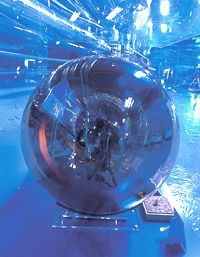|
|
|||||||||||||||||||||||||||||||
Special Feature*
Searching for the origin of the universe,
from 1,000 meters underground: Super-Kamiokande and KamLAND
Will the universe ever die? Before we can answer "yes," we must prove that protons, an essential part of all matter, have a lifespan—in other words, that they will decay to nothing.
In 1996, the University of Tokyo Institute for Cosmic Ray Research finished building a research facility to detect radiation that scientists thought would be emitted if protons decay. The facility is called Super-Kamiokande.
Super-Kamiokande was built in Gifu Prefecture, 1,000 meters under the ground in the abandoned Kamioka mine, where zinc and other minerals were extracted until 2001. The bedrock was carved out to make a cylindrical cavity with a diameter of 40 m and a height of 42 m. A cylindrical tank containing pure water was installed inside, and is surrounded by pure water that fills the cavity. The cylinder has a diameter of almost 40 m. Its interior surface is crammed with more than 10,000 photo multiplier tubes that can detect Cerenkov light (the light produced by radiation from the decaying protons of water molecules). The construction cost for the experimental facility was about 10 billion yen.
Above ground, radiation in the form of cosmic rays produces a faint noise. However, the deeper one goes into the ground, the less disturbance the noise will make. This is why the facility was installed deep underground.
Previously, in 1987, researchers at the predecessor of the Super-Kamiokande facility (a smaller version named Kamiokande), had already observed elementary particles called neutrinos being emitted from an exploding star. Super-Kamiokande is an upgraded version, and was built in order to observe proton decay and to conduct research into neutrinos, about which little was known at the time.
In 1998, neutrinos emitted into the atmosphere were detected at the Super-Kamiokande facility, proving that neutrinos have mass. Until then, it had been believed that neutrinos had zero mass, so the discovery was an important event in the history of physics, and brought instant worldwide fame to the project. Koshiba Masatoshi (76), honorary professor of the University of Tokyo, contributed greatly to the detection of cosmic neutrinos, and received the Nobel Prize for Physics in October 2002.
Also in 1998, the Research Center for Neutrino Science at Tohoku University began constructing another research facility, called KamLAND, for the sole purpose of detecting neutrinos. KamLAND was built at the site of the former Kamiokande, and is similar in structure but slightly smaller in size. It cost 2 billion yen to construct.
|
|||||||||||||||||||||||||||||||

